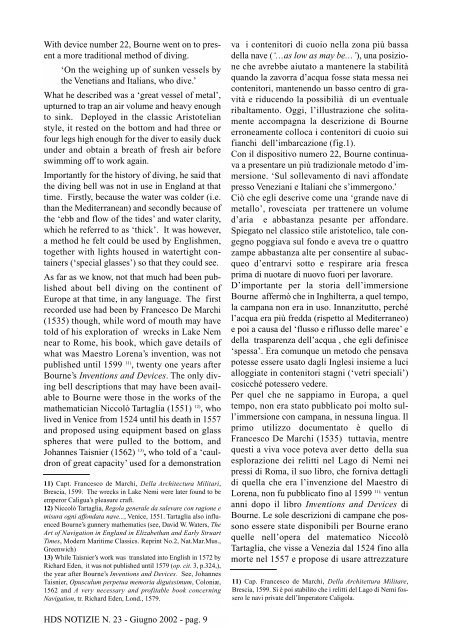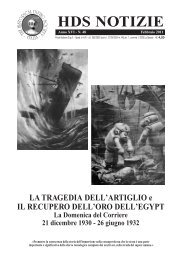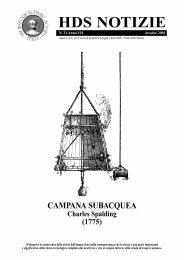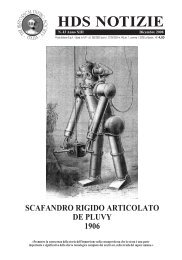hds internet - The Historical Diving Society Italia
hds internet - The Historical Diving Society Italia
hds internet - The Historical Diving Society Italia
You also want an ePaper? Increase the reach of your titles
YUMPU automatically turns print PDFs into web optimized ePapers that Google loves.
With device number 22, Bourne went on to present<br />
a more traditional method of diving.<br />
‘On the weighing up of sunken vessels by<br />
the Venetians and <strong>Italia</strong>ns, who dive.’<br />
What he described was a ‘great vessel of metal’,<br />
upturned to trap an air volume and heavy enough<br />
to sink. Deployed in the classic Aristotelian<br />
style, it rested on the bottom and had three or<br />
four legs high enough for the diver to easily duck<br />
under and obtain a breath of fresh air before<br />
swimming off to work again.<br />
Importantly for the history of diving, he said that<br />
the diving bell was not in use in England at that<br />
time. Firstly, because the water was colder (i.e.<br />
than the Mediterranean) and secondly because of<br />
the ‘ebb and flow of the tides’ and water clarity,<br />
which he referred to as ‘thick’. It was however,<br />
a method he felt could be used by Englishmen,<br />
together with lights housed in watertight containers<br />
(‘special glasses’) so that they could see.<br />
As far as we know, not that much had been published<br />
about bell diving on the continent of<br />
Europe at that time, in any language. <strong>The</strong> first<br />
recorded use had been by Francesco De Marchi<br />
(1535) though, while word of mouth may have<br />
told of his exploration of wrecks in Lake Nem<br />
near to Rome, his book, which gave details of<br />
what was Maestro Lorena’s invention, was not<br />
published until 1599 11) , twenty one years after<br />
Bourne’s Inventions and Devices. <strong>The</strong> only diving<br />
bell descriptions that may have been available<br />
to Bourne were those in the works of the<br />
mathematician Niccolò Tartaglia (1551) 12) , who<br />
lived in Venice from 1524 until his death in 1557<br />
and proposed using equipment based on glass<br />
spheres that were pulled to the bottom, and<br />
Johannes Taisnier (1562) 13) , who told of a ‘cauldron<br />
of great capacity’ used for a demonstration<br />
11) Capt. Francesco de Marchi, Della Architectura Militari,<br />
Brescia, 1599. <strong>The</strong> wrecks in Lake Nemi were later found to be<br />
emperor Caligua’s pleasure craft.<br />
12) Niccolò Tartaglia, Regola generale da sulevare con ragione e<br />
misura ogni affondata nave..., Venice, 1551. Tartaglia also influenced<br />
Bourne’s gunnery mathematics (see, David W. Waters, <strong>The</strong><br />
Art of Navigation in England in Elizabethan and Early Struart<br />
Times, Modern Maritime Classics. Reprint No.2, Nat.Mar.Mus.,<br />
Greenwich)<br />
13) While Taisnier’s work was translated into English in 1572 by<br />
Richard Eden, it was not published until 1579 (op. cit. 3, p.324,),<br />
the year after Bourne’s Inventions and Devices. See, Johannes<br />
Taisnier, Opusculum perpetua memoria diguissimum, Coloniæ,<br />
1562 and A very necessary and profitable book concerning<br />
Navigation, tr. Richard Eden, Lond., 1579.<br />
HDS NOTIZIE N. 23 - Giugno 2002 - pag. 9<br />
va i contenitori di cuoio nella zona più bassa<br />
della nave (‘…as low as may be…’), una posizione<br />
che avrebbe aiutato a mantenere la stabilità<br />
quando la zavorra d’acqua fosse stata messa nei<br />
contenitori, mantenendo un basso centro di gravità<br />
e riducendo la possibilià di un eventuale<br />
ribaltamento. Oggi, l’illustrazione che solitamente<br />
accompagna la descrizione di Bourne<br />
erroneamente colloca i contenitori di cuoio sui<br />
fianchi dell’imbarcazione (fig.1).<br />
Con il dispositivo numero 22, Bourne continuava<br />
a presentare un più tradizionale metodo d’immersione.<br />
‘Sul sollevamento di navi affondate<br />
presso Veneziani e <strong>Italia</strong>ni che s’immergono.’<br />
Ciò che egli descrive come una ‘grande nave di<br />
metallo’, rovesciata per trattenere un volume<br />
d’aria e abbastanza pesante per affondare.<br />
Spiegato nel classico stile aristotelico, tale congegno<br />
poggiava sul fondo e aveva tre o quattro<br />
zampe abbastanza alte per consentire al subacqueo<br />
d’entrarvi sotto e respirare aria fresca<br />
prima di nuotare di nuovo fuori per lavorare.<br />
D’importante per la storia dell’immersione<br />
Bourne affermò che in Inghilterra, a quel tempo,<br />
la campana non era in uso. Innanzitutto, perché<br />
l’acqua era più fredda (rispetto al Mediterraneo)<br />
e poi a causa del ‘flusso e riflusso delle maree’ e<br />
della trasparenza dell’acqua , che egli definisce<br />
‘spessa’. Era comunque un metodo che pensava<br />
potesse essere usato dagli Inglesi insieme a luci<br />
alloggiate in contenitori stagni (‘vetri speciali’)<br />
cosicché potessero vedere.<br />
Per quel che ne sappiamo in Europa, a quel<br />
tempo, non era stato pubblicato poi molto sull’immersione<br />
con campana, in nessuna lingua. Il<br />
primo utilizzo documentato è quello di<br />
Francesco De Marchi (1535) tuttavia, mentre<br />
questi a viva voce poteva aver detto della sua<br />
esplorazione dei relitti nel Lago di Nemi nei<br />
pressi di Roma, il suo libro, che forniva dettagli<br />
di quella che era l’invenzione del Maestro di<br />
Lorena, non fu pubblicato fino al 1599 11), ventun<br />
anni dopo il libro Inventions and Devices di<br />
Bourne. Le sole descrizioni di campane che possono<br />
essere state disponibili per Bourne erano<br />
quelle nell’opera del matematico Niccolò<br />
Tartaglia, che visse a Venezia dal 1524 fino alla<br />
morte nel 1557 e propose di usare attrezzature<br />
11) Cap. Francesco de Marchi, Della Architettura Militare,<br />
Brescia, 1599. Si è poi stabilito che i relitti del Lago di Nemi fossero<br />
le navi private dell’Imperatore Caligola.












